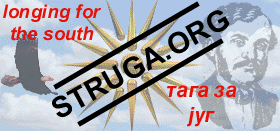
 |
Vevchani Carnival 2005 (Part 1) |
By sundown on Friday, Vevchani had become a scene of carnage. Burning piles of debris, splintered constructions, staggering men in chains and a generally disoriented smog hung over this idyllic village in Macedonia’s southwestern pocket. No, it wasn’t another Balkan war relapse - just the merry unfolding of 2005’s annual carnival.
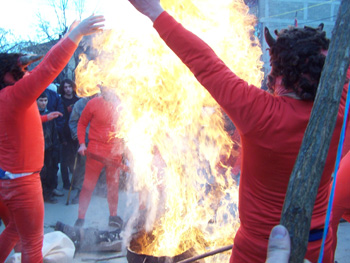 Vevchani's demon hordes delight in tending their bonfire. |
The Vevchani Carnival is a singular manifestation of its historically eccentric and proud people, a two-day blowout party that draws visitors from all over Macedonia and beyond. Held every year on the 13th and 14th of January, the carnival has a long tradition of over 1,400 years and remains one of the most remarkable events to happen every year in Macedonia – and one that reveals, even when the prevailing political, economic and social conditions leave so much to be depressed about, the innate Macedonian capacity for sheer enjoyment and revelry.
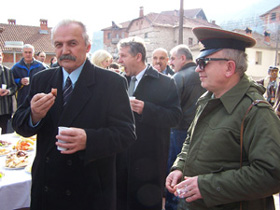 Even Tito made an appearance at the carnival’s opening ceremonies. |
The inaugural ceremony, on Thursday (January 13) at 1 PM, started with a table full of free sausages, pastry and beef kebaps courtesy of the municipality – a sort of early fortification safeguard against the imbibing to come. Actually, since the wine was already circulating at this time, those effects were rather limited.
About an hour later, the opening serenade began, as traditionally clothed musicians, rasping away on zurlas (a kind of wooden horn) and traditionally-dressed drummers pounding insistently on the tapani made their way up to the assembled throng outside the municipality building, where local officials and foreign guests hobnobbed with goblins, cameramen and Josip Broz Tito under the obligatory religious banner.
After this noisome introduction, the main grouped participants of the carnival began gathering from their respective quarters, and a couple of hours later it started. After an introductory speech by Vice Minister of Culture Melpomeni Corneti, the afternoon was reclaimed by the colorful chaos of the 2005 carnival.
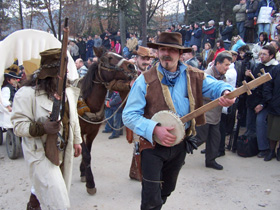 Well armed Wild West outlaws with a horse-drawn cart blaze through the village. |
Led by hooded, erratically dancing children in crimson, the parade began streaming up the hill towards the gathered throngs assembled around Vevchani’s main square.
Lumbering trees bedecked with wild boars, pirates, monsters and all manners of ghouls and phantom dead castigated the crowd, followed by men in white biohazard suits, bakers with a portable oven, nuns on bikes, snake-charming swamis and a horse-drawn cart with artillery fire streaming from the back. Awestruck kids looked on in fascination and cameramen tried to avoid being trampled by participants who were not necessarily sober, including a soot-faced chain gang that moaned under the weight of a long wooden log and tended to collapse in shrieking heaps in a vaguely homoerotic way.
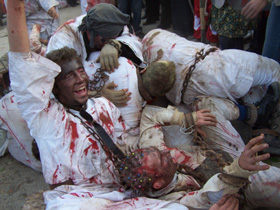 Pigpile! |
According to local historian Ilija Kalanoski, author of two books on the history of Vevchani and its carnival, the village dates to the late sixth or early seventh century, when it and the Struga area in general were settled by the Bersiti or Brsjatsi (one of the Slavic tribes). “They probably decided to stay here,” the author writes, “because of the Jablanica Mountain area’s beautiful nature, rich with wild birds and animals.”
The village assumed a certain degree of importance over the centuries. In the oldest surviving documents to mention the village (late ninth-early tenth century) Vevchani is described as a strong and wealthy town that paid its taxes. Also during the Byzantine period, the village was affected by the church-building works of St. Kliment of Ohrid and figured in the empires of Bulgarian Czars Boris and Simeon the Great.
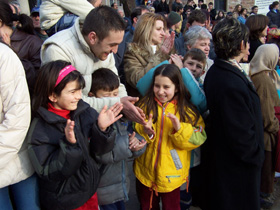 The carnival delighted young and old alike. 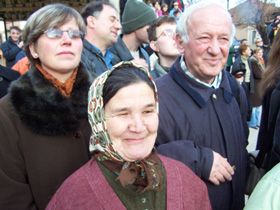
|
Perhaps owing to this unruly lineage, the Vevchani Carnival retains its wild, somewhat dangerous nature even today; indeed, it’s a far cry from some lame festival in the West, where participants brandish plastic swords and fake axes. Here, the first rows of spectators and scrambling photographers alike are within constant striking distance from heavily inebriated, stumbling carnival creatures wielding real metal pitchforks, heavy iron chains, shovels and other tools amidst an acrid haze of constant explosions from improvised incendiary devices and small cannons.